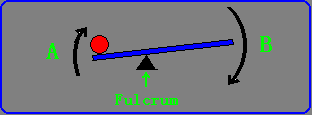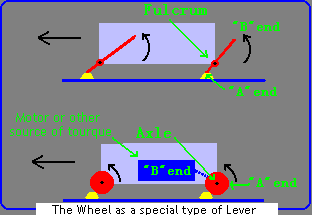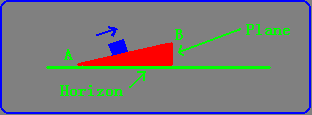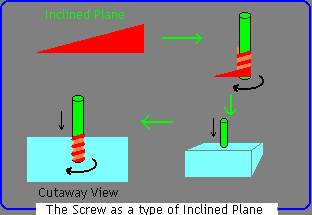
Simple Kinetics
By Rob Meyer
Robots are all about kinetics, or materials in motion. Sure, there may be all sorts of electronic componentry,
optics, computers, and even complex software mixed in as well. But what sets a robot apart from a personal computer,
a toaster, or your bicycle, for instance, is its ability to go out- sometimes completely on its own- and physically
interact with the outside world, (like ripping the wheels off of another robot, perhaps.)
Listed below are the topics I have posted on this page. I have included simple graphics here and there,
but I will try to keep this page as basic as possible so it is easier to update.
I am no expert on physics, and I do not hold an engineering degree.
Still, I hope everyone finds something here of interest. My intention is for our younger viewers to understand how simple machines
and mechanical concepts can be combined to work together in more complex machines- such as robots.
The Lever
A lever is a rigid piece (such as a long bar) that turns about a fixed point (the fulcrum), such that when a force is applied at one end, a proportional force is exerted at the other..?
(just look at the drawing.)

In the drawing, let's assume that the red ball weighs 10 pounds.
If the length of the lever is twice as long from the fulcrum to end "B" as it is to end "A", then it will only take about 5 lbs of force on end "B" to lift the red ball.
This isn't free energy, though. Even though we only have to push half as hard on the "B" end, we have to push it twice as far!
Most simple machines result in some kind of tradeoff between how much force is exerted, and how much time or distance it takes to exert that force.
Many machines rely on levers and on leverage (the action of a lever). It is no wonder that many popular robots take advantage of levers in their designs, especially the lifting and flipping type 'bots such as Biohazard, T-Minus, and Little Sister.

The Wheel
A wheel can be thought of as a special kind of lever, whose short end connects at endless points to form a circle around its fulcrum.
In this scenario, the long end of the lever is omitted, however the rotational force, or TORQUE that it would exert comes from another source, such as a motor. As the mass attached to the fulcrum (which would be an axle or spindle), rolls over an obstacle,
the distance from the outside of the wheel(point "B") to the center, acts as the short end of a lever and lifts the wheeled object over the obstruction.
A single lever could accomplish the same thing, but it could only move the object a little at a time. Since a wheel is, in effect, countless levers arranged about a fulcrum, the resulting motion can be continuous.


The Inclined Plane
An inclined plane is a flat surface that makes an oblique angle to the path of the horizon....??? Again as you can see in the drawing, an inclined plane allows some work to be done,
(such as moving the blue box up to point "B"), to be spread out over a distance, (point "A" to point "B".)
A screw can be thought of as nothing more than an inclined plane wound about a round cylinder. Once again as you can see in the drawing, a screw allows some work to be done, (such as exerting a force against the blue box to hold the bolt in place),
to be spread out over a distance, (In this case, the circumference of the screw times the number of threads.)
An inclined plane is thought of more commonly as a ramp, or...a WEDGE.

The effect, as with the lever, is that we can lift a larger mass by moving it farther along the inclined plane than if we tried to lift it straight up.
Again what we have is a tradeoff between how much force is exerted, and how much time or distance it takes to exert that force.
Many popular robots use inclined planes in their designs- most in the form of wedges. A wedge type robot tranlates the forward force of the robot, (like the red wedge in the drawing), into an upward force under its opponent (the blue box)
in order to send them flying...that is if they can just get under them first!
The Screw
The effect is that we can put many turns on the head of a screw with a wrench (another type of lever, by the way,) while the screw only moves a fraction of an inch.
But because what we are really doing is driving a type of "circular inclined plane" into the box, we can exert a lot of force to hold the bolt.
A special shape of screw called an Auger can be used to move materials from point to point. These can be used to lift grain in a grain elevator,
or as a way to pump large volumes of water up slopes.
These same Auger shaped screws can be seen wreaking havoc on robots as weapons in the BattleBots Arena.
Kinetic Energy and Potential Energy
As they relate to robots, the states of energy we are concerned with here are Kinetic and Potential Energy
Simply stated, Kinetic Energy is the energy of a mass in motion. This can be a saw blade spinning, a hammer swinging, or the wind blowing. Robots can be designed to control their Kinetic Energy very precisely to do things such as weld a car chassis together. They can also be built to weild huge amounts of Kinetic Energy in not-so-predictable ways such as The Judge's mighty hammer coming down to smack a happless opponent.
Potential Energy, on the other hand, is stored energy not yet in motion. Think of pulling back a bow and arrow. When the bow is pulled back, Potential Energy is stored in the tension of the string and the bow frame. If you were never to release the string, nothing would move and no work would be done (except for that of your arm holding everything in tension.)
When the string is released, though, the Potential Energy is transformed into the Kinetic Energy required to send the arrow flying.
Other forms of Potential Energy are:
- A spring under tension
- A rock on a hilltop
- A gas, such as CO2, stored under pressure.
All of these forms of Potential Energy can be released into Kinetic Energy to do work:
- The spring may close a door.
- The rock can begin to roll downhill.
- The gas can be released into a cylinder to move a piston.

Sir Isaac Newton was pretty observant.
Born in England in 1643, he is perhaps best known for his Laws of Motion. They form the basis for all mechanical theory, and are as important today as they were 300 years ago.
- Newton's 1st Law of Motion -
Newton's 1st Law basically states that:
"An object at rest tends to stay at rest and an object in motion tends to stay in motion with the same speed and in the same direction unless acted upon by an unbalanced force."
We use one word to refer to Newton's First Law- "inertia". The effect of inertia is easy enough to illustrate. In round one of the Battlebots eliminations Season 4.0, my Heavyweight battlebot "Black Ops" developed a short circuit in one of its motors. The short fried my primary power circuit rendering my 'bot motionless.
In a supreme example of adherence to Newton's Laws, my robot remained perfectly motionless! Furthermore, it continued to remain motionless until it was acted upon by an unbalanced force- which in this case was the saw blades of heavyweight 'bot "Death Star".

- Newton's 2nd Law of Motion -
Newton's 2nd Law says that:
"The acceleration of an object as produced by a net force is directly proportional to the magnitude of the net force, in the same direction as the net force, and inversely proportional to the mass of the object."
Simply stated, when you whack on something small and slow with something big and fast, the smaller object is going flying -just think Tiger Woods. On the flip side, how far do you suppose Tiger could drive say a 20 pound bowling ball?
In my Combat Robot Tips and Tricks page, I will talk more about the importance of Newton's 2nd Law of Motion as it relates to robot weapons.

- Newton's 3rd Law of Motion -
Newton's 3rd Law is perhaps the Golden Rule of mechanics:
"For every action, there is an equal and opposite reaction."
Another simple illustration: "Vladiator" flies across the battlebox and slams his opponent from the left- his pitiful victim reacts by flying across the arena to the right. Perhaps I've oversimplified, but that's the gist of it.
This has been just a taste of some of the theory behind all machinery. If you look you will see that however complex the machine, whether it be robot "Mechadon", or the Stealth Bomber, the physical workings of it can usually be broken down into the basic elements described on these pages.
For more on how these concepts apply to robots, check out my "Tips and Tricks" pages. For more about elementary physics in general, just type "Newton's Laws of Motion" into any decent search engine. And always remember- use your knowledge for good, not evil!


 , ,
, , 